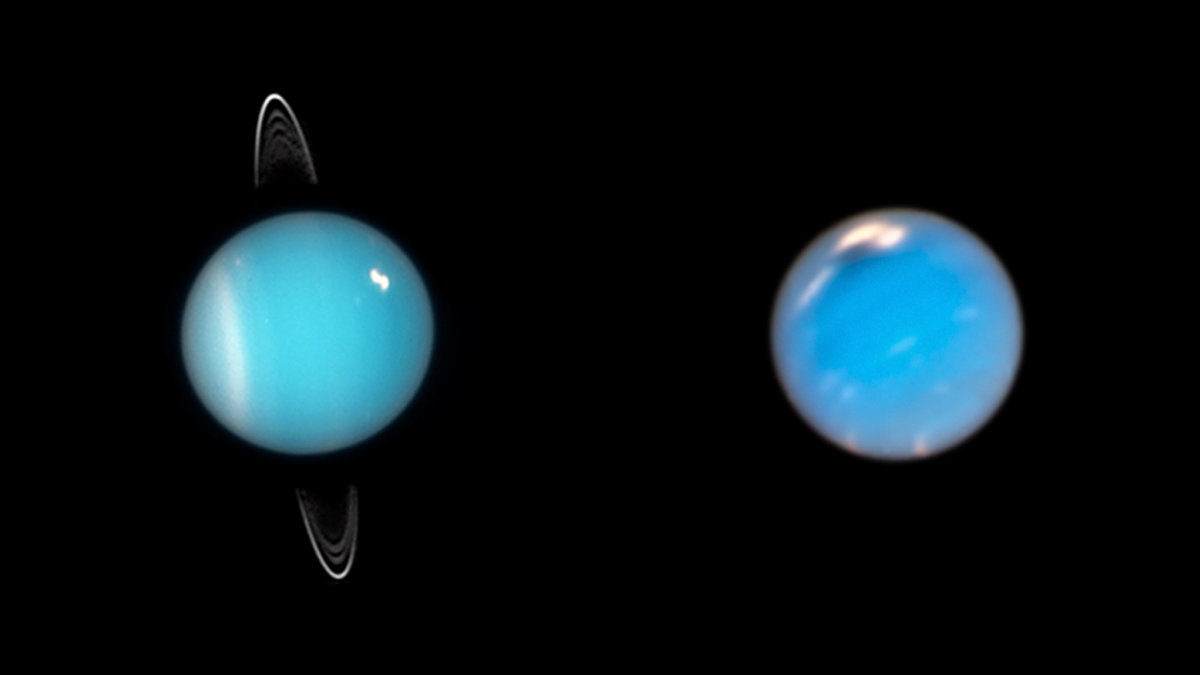When NASA’s Voyager 2 spacecraft made its way to outer regions of the solar system in the late 80’s, it noticed something odd. Both of the ice giant planets, Uranus and Neptune, lacked what’s known as a “dipole magnetic field.” This was in stark contrast to our own rocky world, as well as the two gas giants Jupitar and Saturn.
As dense materials near a planet’s surface cool, they tend to sink into the planet’s interior. On the other hand, hotter materials near the planet’s interior will rise. The combination of sinking and rising materials creates convection, leading to the movement and mixing of materials within a planet. And if the interior of a planet is electrically conducting (as in, made of liquid metal or water), the convecting material — often described as a dynamo — will generate a dipole magnetic field. Think of it like a magnet with north and south poles. It is this process which generates Earth’s magnetic field — the protective barrier that shields us from charged particles.
This process, however, is absent from Uranus and Neptune. So, scientists wondered: Why would that be?
For the last two decades, researchers had speculated that this was because layers of material within these worlds were unable to mix, halting any convection movement which gives rise to dipole magnetic fields in planets like our own. But, while researchers eventually agreed the problem indeed came down to the separation of layers within these worlds, the jury was still out on the compositions of these layers. Now, Burkhard Militzer, a planetary scientist at the University of California, Berkeley, thinks he has an answer.
Related: Why is Neptune’s magnetic field so weird? An exotic molecule may be the answer
“We now have, I would say, a good theory why Uranus and Neptune have really different fields, and it’s very different from Earth, Jupiter and Saturn,” Militzer said in a statement.
Knowing this, 10 years ago, Militzer tried to simulate with computers the interiors of these worlds by cramming roughly 100 atoms of carbon, oxygen, nitrogen and hydrogen (in proportions that mirrored their abundances at the early stages on the solar system) at pressure and temperatures that mirrored their interiors. Yet, they yielded no distinct layers.
Fast forward to last year, and with the help of machine learning, Militzer was able to simulate the behavior of 540 atoms with similar ratios, and he found that layers would naturally form as the atoms were heated and compressed. “One day,” he said, “I looked at the model, and the water had separated from the carbon and nitrogen. What I couldn’t do 10 years ago was now happening.”
“I thought, ‘Wow! Now I know why the layers form: One is water-rich and the other is carbon-rich, and in Uranus and Neptune, it’s the carbon-rich system that is below. The heavy part stays in the bottom, and the lighter part stays on top and it cannot do any convecting,” he said.
Militzer’s model predicts that underneath the 3,000-mile-thick (just over 4,800 kilometers) Uranian atmosphere sits a vast water-rich layer 5,000 miles deep (just over 8,000 kilometers). Below that, a 5,000 mile thick hydrocarbon-rich layer also exists, with a rocky core about the size of Mercury at its center.
Despite being more massive than Uranus, Neptune has a smaller total diameter and thinner atmosphere compared to its icy compatriot. However, it is likely to share similar differentiated water-rich and hydrocarbon-rich layers, with a Mars-size rocky core (providing the extra mass).
“If you ask my colleagues, ‘What do you think explains the fields of Uranus and Neptune?’ they may say, ‘Well, maybe it’s this diamond rain, but maybe it’s this water property which we call superionic,'” Militzer said. “From my perspective, this is not plausible. But if we have this separation into two separate layers, that should explain it.”
Militzer hopes he might one day be able to test his hypothesis with laboratory experiments that mirror the interior conditions of these worlds. A mission to Uranus could also provide answers, Militzer says.
The paper was published on Nov. 25 in the Proceedings of the National Academy of Sciences.
Source link
